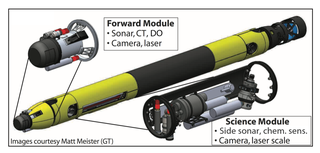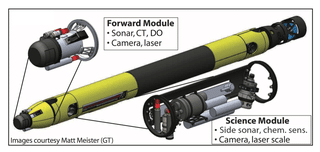(Joe Pappalardo) It’s hard to get over putting your life’s work in harm’s way. Britney Schmidt hasn’t. The Georgia Tech researcher has tested the limits of underwater robots swimming beneath Antarctic ice shelves, a dry run for looking for life in outer space, and it hasn’t gotten any easier.
by Joe Pappalardo, January 25th, 2018
Anytime you take your whole program’s work and dangle it off of a fiber optic cable through meters of ice…it’s a little unnerving,” Schmidt tells Popular Mechanics, emailing from the Antarctic research station on the south tip of Ross Island.
This week, Schmidt and her team of researchers are leaving the Antarctic after a busy three months at the far end of the Earth. They are testing Icefin, a drone built to explore the extreme ecosystems lurking beneath thick ice. The waters beneath our planet’s ice sheet are fascinating, turning up species few people have ever laid eyes on. But they are not the final target of this chase.
Alien Seas
Icefin is meant to search for alien life—a “bug hunt,” as some scientists cheerfully call it. It is bound for the icy waters of Jupiter’s moon, Europa, possibly as soon as 2030.
“The new equipment includes new sensors…to see if Europa could support the rise of life.”
“Icefin is capable of deploying through small drill holes in the ice, similar to what will one day be needed to explore Europa,” Schmidt says. “In the meantime, this project is looking to understand how ice-ocean interactions operate in Antarctica, and how these processes may couple to biological communities.”
Like many subsea drones, the 10-foot-long Icefin is shaped like a torpedo. It made headlines in 2014 as one of the prototype drones that plumbed the Antarctic as part of a NASA program to test the technology. Now, a new program called the Ross Ice Shelf and Europa Underwater Probe (RISE UP), NASA is funding three expeditions to put an upgraded Icefin under the ice. This was its first deployment.

Icefin
Matt Meister
The new equipment includes sensors to monitor for organics and measure environmental factors like the presence of dissolved oxygen and levels of acidity, all to see if Europa could (in theory) support life in its subterranean seas.
“We got Icefin flying great, exercised all of our instruments, and got great data from three different target sites,” Schmidt says, “including traversing over two kilometers out under the McMurdo Ice Shelf, reaching the sea floor below the shelf at two areas locations and depths [530 meters and around 800 meters], and surveyed the Erebus glacier tongue.”
On Its Own
The subsea drone is also smarter than its prototype predecessor, and that high-IQ autonomy would be needed on Europa. The probe must not only operate 400 million miles from Earth but also navigate all by itself under alien ice.
“Icefin is tethered, but it’s mostly so that we can do piecemeal development and not lose it under the ice. Autonomy anywhere is challenging, but when there are meters of ice between you and the vehicle, the risk is incredibly high,” she says. “We’ll definitely need that kind of capability for Europa…it will need to decide, based on science sensors on board, what the optimum data to take and send back will be.”

The Icefin team.
One of the team’s goals for these Antarctic trials is to test the instruments and compare the data to “ground truth” measurements. Basically, if you send an Icefin all the way to Europa, you want to make sure the drone is delivering trustworthy results.
“The scariest moment for me was the first time we had a power system anomaly that shut off the main vehicle computer,” Schmidt says. “The power came right back and we had the system up and going in short order, but it’s the kind of thing you don’t learn about your system until you get it out in the field and really drive it hard.”
Over the next nine months, the RISE UP team working back at the Atlanta campus will add more instruments, a new cell counter, and possibly a microscope. The next phase of research, expected to launch in October, will focus on Icefin’s autonomy. The third and final expedition will test the drone’s sampling systems and on-the-fly decision making. The team is also designing an arm for Icefin as a longer-term project.
Far Ends
Antarctica is a dream for many scientists, but the reality is hard work in extreme conditions. “In the field we worked 6 or 7 days a week, usually 12 or more hours in order to get everything accomplished,” Schmidt says. “It’s a high-pressure environment for the science and engineering teams because you have such short time to accomplish what you’ve planned.”
Although Antarctica offers a close facsimile to the Europe’s frigid waters, the extreme conditions come with some downsides. One of Schmidt’s final and grandest aspirations was to become the first team to operate a vehicle to explore the area under the Ross Ice Shelf, dropping Icefin through a borehole drilled at the remote HWD2 field camp. Her team had their gear packed and ready to go, but the weather was not cooperating.
“The weather—yeah, the weather,” she laments. “This year, a 500-mile fog bank parked itself over our deep field camp, and every time it cleared was during a time when the planes don’t fly, so we never made it out there. That was absolutely heartbreaking.”
Despite the letdown, Schmidt calls this research season a huge success for Icefin. Examining the results, the team is finding that the ice shelf dives produced reams of data that “paint a beautiful picture of how things change spatially under the ice.”
But because this mission is a centered on the search for life, Schmidt encountered other alien life of sorts, animals that few people on Earth have ever seen.
When Icefin dove to the sea floor it found odd, feathery creatures waiting for them. “My favorite moments from the seafloor were our visits by crinoids…it was incredible to behold,” she says, referring to the to the odd, feathery dwellers that call Antarctica home.
Who knows what other incredible things Icefin might see beneath the ice on Jupiter’s sixth rock.
Author:
External news: Joe Pappalardo Jan 4, 2018 – Popularmechanics.com
_________________________
Stillness in the Storm Editor’s note: Did you find a spelling error or grammar mistake? Do you think this article needs a correction or update? Or do you just have some feedback? Send us an email at sitsshow@gmail.com with the error, headline and url. Thank you for reading.

Leave a Reply